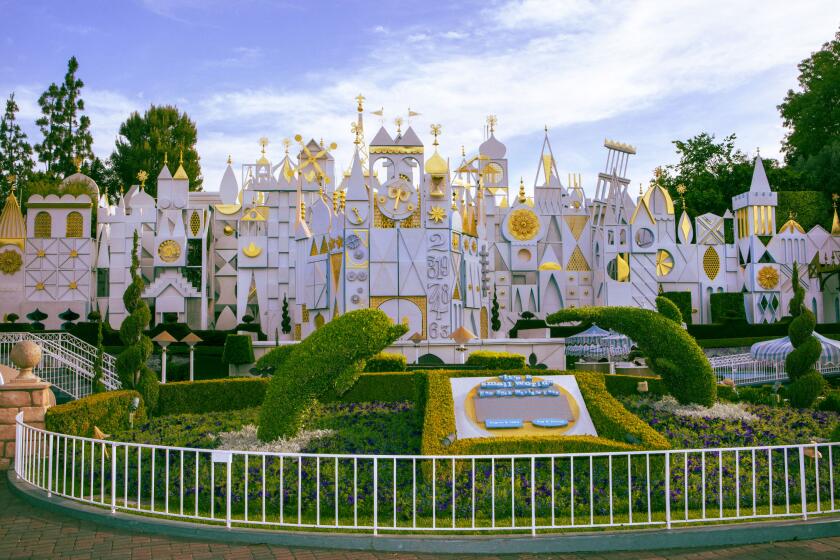It’s a Grave Misunderstanding
- Share via
For three years, his painstaking work to preserve Civil War tombstones in a Santa Ana graveyard was lavished with praise -- from history buffs, veterans groups, cemetery officials and a congresswoman.
But now, Gene-o Platt is watching in dismay as a squad of Boy Scouts prepares to undo his labor of love.
For the record:
12:00 a.m. July 28, 2005 For The Record
Los Angeles Times Thursday July 28, 2005 Home Edition Main News Part A Page 2 National Desk 1 inches; 32 words Type of Material: Correction
Civil War tombstones -- A headline on an article in Wednesday’s California section about Civil War tombstones in a Santa Ana cemetery said they were made of granite. They’re made of marble.
Under orders from the Orange County Cemetery District, the marble headstones at Santa Ana Cemetery will soon be stripped back to their earlier state.
“It’s heartbreaking,” said Platt, who spent 3 1/2 years crawling around the tree-lined graveyard, refurbishing about 180 Civil War veterans’ headstones. Leaning on a sheepskin-covered footstool, he scraped off fungus and lichen, then brushed several layers of white-pigmented sealer onto the Georgia marble. With drills and grinding tools, he enhanced worn lettering, which he then painted gold.
After finishing, he said a prayer over each grave.
Operating with permission from cemetery officials, he invested thousands of hours and dollars in the project, hoping his example would be copied nationwide.
Instead, it’s being called a well-intentioned mistake.
Applying sealer to marble can cause the stone to deteriorate from the inside out because moisture in the rock can’t escape, said Fred Oakley, a conservator with the Assn. of Gravestone Studies in Massachusetts.
Several other preservation experts agreed.
For that reason, the Veterans Administration, which owns Civil War tombstones, bars sealer from being applied to its monuments, said Mike Nacincik, a spokesman for the VA’s National Cemetery Administration.
The VA also frowns on the gold paint that Platt used. “We use black lithochrome paint for lettering,” Nacincik said.
So, why didn’t anyone stop Platt?
“We didn’t know it was a violation of federal policy,” said Sam Randall, general manager for the Orange County Cemetery District, which oversees Santa Ana Cemetery, Anaheim Cemetery and El Toro Memorial Park.
Nacincik said cemetery district officials had no excuse for failing to act: “I would assume they’re professionals like us and would understand that putting sealer on marble isn’t beneficial.”
Nacincik said he hoped the chemical solvent being used to strip off the sealer wouldn’t cause further damage.
Platt, a Santa Ana resident who spent seven years in the Air Force as a radar technician, began his project in 1998 after visiting his wife’s grave and noticing the aging Civil War markers nearby.
Cemetery officials not only endorsed his effort, but offered $1,000 so he could replace the metal stars affixed to the graves. Platt turned down the money, deciding to rely instead on private donations.
The district didn’t contact the Veterans Administration until 2002. By then, Platt’s work had been honored by Rep. Loretta Sanchez (D-Santa Ana), the Santa Ana Historical Preservation Society and the Sons of Union Veterans of the Civil War.
When cemetery district officials told Platt to stop in March 2002, his supporters drummed up 200 signatures urging the agency to let him continue.
“He’s preserving history, preserving the memory of veterans buried there,” said George L. Powell, commander in chief of the Sons of Union Veterans.
“I’m appalled they won’t let him finish.”
Three years later, the county cemetery district has decided to use a biodegradable chemical to dissolve Platt’s sealer and gold lettering.
“His intentions were good ... but in the final analysis, we’ve done something wrong and need to undo it,” Randall said.
Platt doesn’t buy the district’s reasoning: “I checked with so many people before I did this. The sealer does more good than harm.”
On Monday, clutching a brown cane and wearing an Air Force pin on his shirt, he strolled the cemetery grounds, proudly showing off his work, including repairs made to a broken golden eagle statue near the Santa Clara Avenue entrance.
To those who have criticized his efforts from afar, Platt said, “Tell them to come out and look at the results.”
Before, he said, the names on some of the tombstones were unreadable. Now, schoolchildren who visit the cemetery come away with a better grasp of Civil War history, he said.
One headstone that Platt revitalized memorializes a veteran born in 1855, meaning he joined the Union Army between age 6 and 10, perhaps as a water boy or drummer.
Platt has piles of letters from cemetery visitors and neighbors thanking him for cleaning and refurbishing the markers.
“Everything I did was from the heart,” he said. “This is the treatment these graves deserve.”
Roger Shortall, a friend who helped Platt restore the metal stars, agreed: “I’ve been across the U.S., and I stop in at every cemetery I can find. The gravestones are usually falling over and are covered with lichen and moss. They don’t have stars. Here, they’re very well-honored.”
Platt is now praying someone will intervene. The solvent, which is on order from a Maryland company, is expected to arrive in August, with Eagle Scout volunteers ready to handle the work.
Platt realizes he faces long odds. “Maybe everyone will start taking better care of these monuments, even if I lose,” he said.
*
Times staff writer Jeff Gottlieb contributed to this report.
More to Read
Sign up for Essential California
The most important California stories and recommendations in your inbox every morning.
You may occasionally receive promotional content from the Los Angeles Times.










